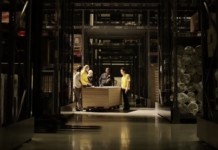Adidas is a german company but produces its sporting goods in Asia since ages. The fabricator has announced to launch the first ever production line that is run by robots in Germany. In 2017 they will start producing next door.

20 years ago all production lines were moved to Asia. Chief executive Herbert Hainer now proudly presents the “Speedfactory” in a press conference in Ansbach, Germany.
The plant is 4,600 square meters big and currently under construction. But Adidas opened the doors for the press already before finishing. The goal of the plant is to automate the shoe making process and thus increase efficiency.
The majority of all products is produced manually. The cheap labor cost in Asia was, and still is very attractive for large companies. A new factory in Germany would allow to produce and deliver products way faster than before.
In the second half of 2016 there will be a first test run: round 500 pairs of shoes will be produced by robots. The actual production is going to start the next year. Besides Germany Adidas also uses the US as a trial project of the futuristic, automated production.
Herbert Hainer does not aim for a full automatisation though. All plants in Asia, including their employees, continue to exist. The robotic is not replacing any men-run plants, so The Guardian.
Adidas need to hit its targets

Adidas produced 301 million pairs of shoes in 2015. To hit growth targets they have to sell 30 million more, every year until 2020.
Six partners of Adidas could not, or didn’t want to comment on current developments in Germany, which is only the beginning of Adidas’ strategy. In the long run there will be more automated plants in Europe, one in Britain and one in France. Soon it will be even possible to produce german national tricots in our home country.
The price for shoes is probably not going to drop with a more efficient supply chain. Consumers will have to pay the same amount of money for their beloved products.









